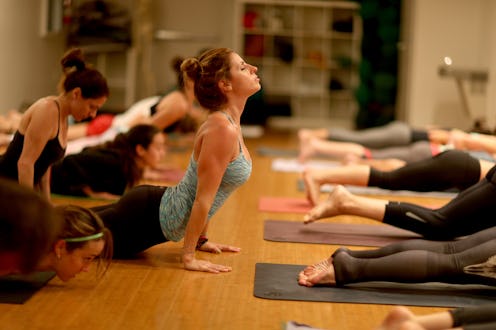Life
Bikram Yoga Might Not Be As Good For You As You Thought, According To New Research

If you've been doing yoga at hotter-than-preferable temperatures because you've been told it's better for you than regular yoga, you might need to take child's pose. A new study suggests that Bikram yoga might not be better for your health than other forms of the exercise. The study published in the journal Experimental Physiology found that benefits of yoga, like the reduction of changes in the lining of blood vessels that are involved in the development and progression of heart disease, exist at the same rate when yoga is performed at room temperature as when it's performed in a hot room.
Bikram yoga, named for its founder, Bikram Choudhury, is traditionally a sequence of 26 postures performed in a room heated to 105 degrees and 40 percent humidity for 90 minutes, which is, as anyone who's done it before can attest, intense. The Bikram website noted that this method of yoga systematically works every part of the body to give "all the internal organs, all the veins, all the ligaments, and all the muscles everything they need to maintain optimum health and maximum function. [...] These studios are built in such a way that you always get the proper heating which help you [practice] your postures optimally. Bikram literally calls these studios 'Torture Chambers," but some people swear by them, saying they feel more open and flexible afterwards than they do after room-temp yoga.
If the idea of exercising in an unbearable swamp-like environment is your idea of hell, corresponding author of the study Stacy D. Hunter noted: "The new finding from this investigation was that the heated practice environment did not seem to play a role in eliciting improvements in vascular health with Bikram yoga," according to a press release.
While many people swear by Bikram yoga, Jody Kurilla, owner of Yoga Shala in Portland, Ore., told HealthLine, "The idea is if you’re sweating a lot, the session is too difficult. You can be lightly sweating, but if your [breathing] or your heart rate starts to go up, you’re supposed to take a break. So to put yourself into a hot room, and do that on purpose, it’s not what yoga was designed to do. You’re supposed to be cultivating prana, or energy, not dispersing it.”
What's more, an article in Yoga Journal noted that researchers at the University of Wisconsin explained that raising your core body temperature over 103 degrees can be dangerous and can induce symptoms of heat exhaustion, including mild nausea, dizziness, headache, unsteadiness, and mild cramps. If you start to feel this way, common sense indicates that you should leave the room to cool down, but this isn't always feasible or encouraged. One Reddit user posted that she was allegedly shamed for trying to leave her Bikram class after she began to feel uncomfortable. "The teacher intercepted me on the way and suggested I stay because of the supposed harm of sudden temp change, I said I was nauseous and wanted to leave, he tried to get me to stay again," Reddit user findacity wrote. She went on to say that once she was in the hallway an employee of the studio also discouraged her to from leaving the class.
It's true that there are many health benefits to sweating, including cleaning your pores and expelling toxins, which supports proper immune function and helps prevent diseases related to toxic overload, killing viruses and bacteria that cannot survive in temperatures above 98.6 degrees, and relieving stress and promoting relaxation, according to author and doctor Joseph Mercola's blog. However, the New York Times reported that Bikram yoga "could raise the risk of overstretching, muscle damage, and torn cartilage."
While Bikram may not be any better for you than yoga practiced at room temperature, FAR infrared yoga is reported to have additional benefits. And, this type of yoga is not hot. A region in the infrared spectrum of electromagnetic radiation, FAR infrared radiation (FIR) has several reported healing benefits. According to a study in the journal Experimental Biology and Medicine, it may be a beneficial complement to treatments for some chronic diseases that yields no adverse effects.
"FIR rays may have striking therapeutic effects on medical treatments on the basis of a circadian rhythm," the study concluded. Other reported benefits cited include reducing stress and fatigue, the ability to potentially alleviate strokes, increasing blood flow, and more. The bottom line? While sweating is good for you, it's not necessary to torture yourself to get the health benefits of yoga.